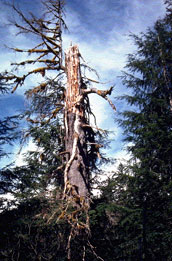A Guide to Building and Placing Birdhouses
Save a Snag for Wildlife
Dead trees, or snags, are valuable to a wide variety of wildlife. Unfortunately, many people assume snags are of no value and routinely cut them down. In some places, this practice has caused cavity-nesting bird and mammal populations to decline. Though nest boxes may provide alternate nesting sites for some cavity-nesting birds, they are not suitable replacements for dead trees. Here's why:

-
Snags provide homes for woodpeckers. Woodpeckers use snags for drumming, nesting, roosting, and feeding.
Woodpeckers hammer their bills against the resonating surface of dead tree trunks to make a loud drumming sound;
this is their courtship and territorial “song.” Snags provide ideal feeding sites for woodpeckers as
many insects live and reproduce in decaying wood. Many snags are covered with small holes made by foraging
woodpeckers.
Though woodpeckers have powerful bills and neck muscles, they are only able to excavate nests in trees with soft decaying centers. Thus, dead or dying trees are preferred excavation sites. Unlike most other cavity-nesting birds, woodpeckers rarely use birdhouses. - Snags with old woodpecker holes provide homes for swallows, chickadees, nuthatches, bluebirds, owls, and other cavity-nesting birds that are rarely able to excavate their own nest sites.
- Snags provide ideal hunting perches for Red-tailed and Rough-legged Hawks, Bald Eagles, Hawk Owls, Great-horned Owls, and other raptors.
- Snags provide “songposts” to a wide variety of birds. Many small birds use songposts sticking above other vegetation to sing (to attract mates and proclaim nesting territory boundaries) and to perch on when looking out for predators and/or other birds.
- Snags provide “hawking” perches for flycatchers and resting perches for swallows. Flycatchers perch on a branch, fly out to snatch insects, and then return to the same branch to watch for other insects.
- Large natural cavities, formed in snags by decay, often provide homes for a variey of mammals including marten, porcupine, bats, bushy-tailed woodrats, northern flying squirrels, and other species.
- When left to decay and fall over naturally, large hollow snags may provide den sites for larger animals like mink, lynx, red fox, and wolverine.
To help provide homes for this wide variety of animals, leave dead trees standing whenever possible, particularly snags larger than 6 inches in diameter and/or any containing woodpecker holes or other cavities.
